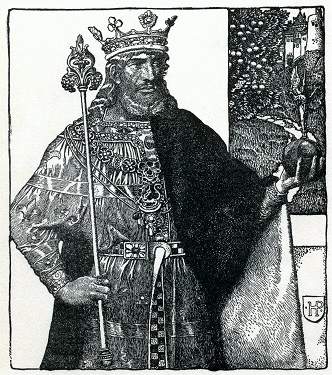Nazca Lines: Astonishing Preservation Against All Odds
Sprawled across the arid plains of southern Peru, a vast tapestry of lines, shapes, and figures emerges from the earth, their origins shrouded in mystery and time. The Nazca Lines, as they are famously known, have captured the imagination of scholars, travelers, and dreamers alike. These intricate geoglyphs, etched onto the desert floor, stand as silent testaments to the artistic prowess and vision of the ancient Nazca civilization.
Yet, despite decades of research and exploration, they continue to pose more questions than answers. How were they created? What purpose did they serve? Why do they endure? As we embark on this journey through the sands of time, we’ll delve into the secrets, theories, and marvels of these UNESCO World Heritage-listed phenomena. Let the Nazca Lines draw you into their enigmatic embrace, and let’s unravel the tales they’ve woven for centuries.
- Discovering the Nazca Lines: A Bird's-Eye View of Ancient Wonders
- The Artistry and Scale: Beholding the Grandeur of the Nazca Geoglyphs
- Theories Behind Their Creation: Deciphering the Intent of the Nazca Lines
- Technique and Craftsmanship: Crafting Marvels in the Desert Sands
- Astronomical Connections: The Nazca Lines and the Cosmos
- Cultural and Ritualistic Significance: The Nazca Lines as Spiritual Landmarks
- Conservation and Preservation: Safeguarding the Desert's Timeless Canvas
- Visiting the Nazca Lines: A Journey Through Time and Desert Sands
- Nazca Lines in Popular Culture: From Desert Sands to Global Imaginations
- A Desert's Whispered Secrets and Humanity's Endless Quest
- Embark on Your Own Desert Odyssey
Discovering the Nazca Lines: A Bird’s-Eye View of Ancient Wonders
Long before the age of modern technology and aerial photography, the vast geoglyphs of the Nazca Desert remained hidden in plain sight, their grandeur obscured by their sheer scale. It wasn’t until the advent of modern flight that these wonders truly came into the global spotlight.
Initial Sightings
In the early 20th century, as airplanes began to traverse the skies above southern Peru, pilots reported seeing vast drawings etched into the desert floor. These aerial sightings stirred intrigue, but the lines’ full extent and significance remained largely unappreciated.
Maria Reiche: The Lady of the Lines
One of the most dedicated researchers of the Nazca Lines was German mathematician and archaeologist Maria Reiche. Beginning her studies in the 1940s, Reiche devoted over 50 years to measuring, mapping, and studying the geoglyphs. She was instrumental in bringing global attention to the Nazca Lines and advocating for their preservation.
Global Recognition
With increased research, the Nazca Lines started garnering international attention. Scholars, archaeologists, and curious travelers flocked to Peru, eager to study or simply marvel at these ancient wonders.
UNESCO World Heritage Status
In recognition of their cultural significance and historical value, the Nazca Lines were designated a UNESCO World Heritage Site in 1994. This status highlighted their global importance and bolstered efforts to preserve and protect them.
Modern Exploration
Today, with the aid of satellite imagery, drones, and advanced geospatial technologies, researchers can study the Nazca Lines with unprecedented detail. New geoglyphs, previously undiscovered or overlooked, continue to be identified, adding to the richness and complexity of the site.
The discovery of the Nazca Lines is a testament to humanity’s relentless curiosity and the serendipity of modern advancements. What was once hidden beneath the feet of the Nazca people now unfurls majestically from the skies, inviting the world to ponder, appreciate, and decode its mysteries.
The Artistry and Scale: Beholding the Grandeur of the Nazca Geoglyphs
When first viewing the Nazca Lines, one is immediately astounded by their sheer size and complexity. Stretching across the vast expanse of the Nazca Desert, these geoglyphs are not just monumental in size but also in their artistic precision and attention to detail.
Diverse Designs
From stylized hummingbirds and spiders to intricate geometric patterns, the Nazca Lines showcase a wide array of designs. Each geoglyph, meticulously etched into the desert floor, reveals a glimpse into the artistic sensibilities and cultural symbols of the ancient Nazca civilization.
Monumental Proportions
Some of the Nazca geoglyphs are colossal, spanning hundreds of meters in length. The sheer size of these drawings is awe-inspiring, especially considering they were crafted without the advantage of an aerial perspective.
Precision and Symmetry
Despite their grand scale, the Nazca Lines are remarkably precise. The lines are straight, the curves are symmetrical, and the representations of animals and plants showcase a keen observational eye. Such precision suggests advanced planning, tools, and perhaps communal efforts in their creation.
Environmental Mastery
The very fact that these lines have survived for over a millennium is a testament to the Nazca people’s understanding of their environment. They chose areas with minimal wind erosion and cleverly used the natural color contrast between the reddish-brown desert surface and the lighter soil beneath to create lasting images.
Viewing Platforms
It’s believed that the Nazca people may have created natural or man-made viewing platforms or hills from which certain geoglyphs could be observed, further showcasing the thoughtful planning behind these artworks.
Beyond Visual Appeal
While the Nazca Lines are undeniably artistically impressive, many researchers believe that their significance goes beyond mere aesthetics. Their strategic placements, sizes, and chosen designs might have had cultural, religious, or astronomical implications, adding layers of depth to their artistry.
In delving into the artistry and scale of the Nazca Lines, we witness a confluence of creativity, technical skill, and profound cultural expression. These geoglyphs, set against the stark beauty of the desert, are not just ancient artworks but a resounding testament to the indomitable spirit and ingenuity of the Nazca people.
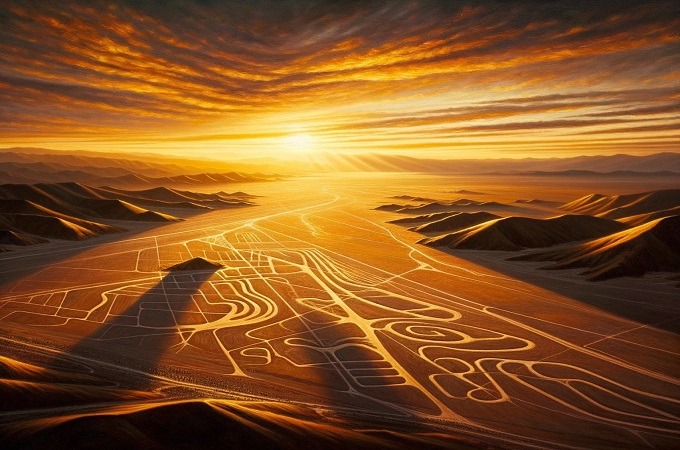
Theories Behind Their Creation: Deciphering the Intent of the Nazca Lines
The Nazca Lines, with their mesmerizing artistry and vast scale, have long been a source of intrigue and speculation. Over the decades, numerous theories have been proposed regarding their creation and purpose. While definitive answers remain elusive, these hypotheses offer fascinating insights into the possible motivations and beliefs of the ancient Nazca civilization.
Astronomical Alignments
Some researchers suggest that the Nazca Lines functioned as an astronomical calendar or observatory. Certain geoglyphs might align with celestial bodies or mark solstices, equinoxes, or other significant astronomical events, aiding the Nazca people in tracking time or planning agricultural activities.
Ritualistic Pathways
Another theory posits that the lines served as sacred pathways for religious rituals or ceremonial processions. The geoglyphs could demarcate spaces where offerings were made, prayers were chanted, or dances were performed to appease deities or seek blessings.
Water and Fertility Symbols
Given the arid environment of the Nazca Desert, water was of paramount importance. Some believe that the lines were symbolic representations, created to invoke rain or ensure the fertility of the land. Geoglyphs like the hummingbird or the monkey, often associated with water or fertility in various cultures, lend credence to this theory.
Art for Art’s Sake
It’s possible that the Nazca Lines, in all their complexity, were primarily artistic expressions. The desert might have served as a vast canvas where the Nazca people showcased their creativity, cultural symbols, and narratives, much like we create murals or street art today.
Landmarking and Navigation
Some theories suggest that the Nazca Lines functioned as markers or navigational aids, guiding travelers or traders across the desert. The geoglyphs could indicate routes, water sources, or significant settlements.
Extraterrestrial Speculations
While less grounded in scientific evidence, there are theories that attribute the Nazca Lines to extraterrestrial beings or ancient astronauts. Proponents argue that the scale and precision of the geoglyphs might indicate knowledge or technology beyond the Nazca civilization’s capabilities.
A Confluence of Purposes
It’s plausible that the Nazca Lines served multiple purposes simultaneously. They could have been astronomical markers, ritualistic pathways, and artistic expressions, reflecting the multifaceted beliefs and practices of the Nazca people.
While we might never fully unravel the intentions behind the Nazca Lines, these theories shine a light on the profound cultural, spiritual, and intellectual richness of the Nazca civilization. Each hypothesis, whether rooted in science, folklore, or imagination, adds another layer to the enduring enigma of these desert wonders.
Technique and Craftsmanship: Crafting Marvels in the Desert Sands
The Nazca Lines, as grand and intricate as they are, represent an incredible feat of engineering and artistry, especially given the technological constraints of the era in which they were created. Delving into the techniques employed by the ancient Nazca people reveals not just their artistic vision but also their profound understanding of the desert landscape and its challenges.
Simple Tools, Grand Designs
Contrary to what their complexity might suggest, the Nazca Lines were likely created using simple tools. Wooden stakes, ropes, and basic hand tools would have been employed to mark and carve out the designs.
The Trampling Technique
Researchers believe that the Nazca people created the geoglyphs by removing the reddish-brown iron oxide-coated pebbles that cover the Nazca Desert’s surface. Underneath these pebbles, the soil is much lighter. By trampling down and clearing away the darker rocks, they revealed the lighter ground beneath, creating the stark contrast that makes the lines visible.
Preservation by Environment
One of the most astounding aspects of the Nazca Lines is their preservation. The Nazca Desert’s unique climate has played a significant role in this. With minimal wind and rain, the geoglyphs have remained largely undisturbed for centuries.
Planning and Precision
The straight lines, perfect curves, and symmetry of the geoglyphs indicate careful planning. It’s believed that the Nazca people might have used smaller models or sketches as references and then scaled them up on the desert floor.
Depth and Dimensions
While the lines might appear shallow, they can be between 10 to 30 cm deep. Their width varies, with some of the broader lines spanning over 1.3 meters. This variability in depth and dimension demonstrates a keen understanding of perspective and visibility, ensuring the lines remained discernible from a distance.
Community Endeavors
Given the scale of the Nazca Lines, it’s likely that their creation was a communal effort. Large groups would have come together, playing distinct roles in the marking, clearing, and maintenance of the geoglyphs.
A Living Canvas
Evidence suggests that the Nazca Lines weren’t created at a single point in time. Instead, they evolved over centuries, with new geoglyphs being added and older ones modified, reflecting the evolving cultural and spiritual narratives of the Nazca civilization.
The technique and craftsmanship behind the Nazca Lines underscore the harmonious blend of artistry, environmental understanding, and community spirit of the Nazca people. Their legacy, etched in the sands, stands as a testament to human ingenuity and the timeless drive to create and communicate.
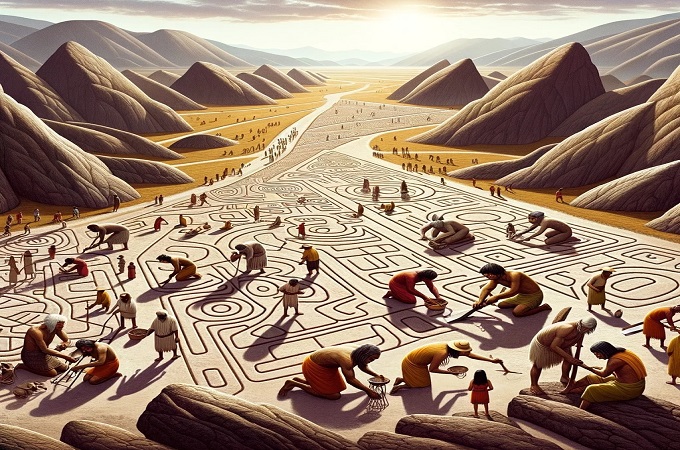
Astronomical Connections: The Nazca Lines and the Cosmos
Among the myriad theories surrounding the Nazca Lines, their potential astronomical significance has been a focal point of research and debate. These vast geoglyphs, sprawled across the desert floor, might be more than just artistic expressions; they could serve as windows to the ancient Nazca civilization’s understanding of the cosmos.
Solstice and Equinox Alignments
Several of the Nazca Lines, especially the straight lines, appear to align with the positions of the sun, moon, and certain stars during solstices and equinoxes. This has led researchers to speculate that the lines could have functioned as an ancient astronomical calendar, marking significant times for agricultural or ceremonial activities.
Star Patterns
Some scholars believe that certain geoglyphs, like the spider or the monkey, correspond to constellations or star patterns visible in the southern sky. These representations might have held spiritual or mythological significance for the Nazca people.
Observation Points
The Nazca Desert features natural hills and platforms, which could have served as observation points for tracking celestial movements. Some of these vantage points align perfectly with specific geoglyphs, hinting at a deliberate astronomical intent.
Lunar and Planetary Alignments
Beyond the sun and stars, some researchers suggest that the Nazca Lines might align with the trajectories of planets or the moon’s phases. These alignments could be associated with myths, rituals, or agricultural cycles.
Rituals and Cosmic Events
The Nazca civilization, like many ancient cultures, might have attributed celestial events (like eclipses or meteor showers) to divine interventions or omens. The lines could have been sites for rituals or ceremonies intended to appease, invoke, or celebrate cosmic deities.
Skepticism and Counterarguments
While the astronomical connections are compelling, they are not universally accepted. Critics argue that the alignments might be coincidental, given the sheer number of lines and designs. They emphasize the need for more concrete evidence before drawing definitive conclusions.
A Broader Cultural Context
Regardless of their precise astronomical significance, the Nazca Lines undeniably reflect a culture deeply attuned to its environment and the cosmos. Whether used for tracking time, marking seasons, or spiritual pursuits, the lines offer insights into the Nazca people’s cosmic worldview.
In exploring the astronomical connections of the Nazca Lines, we delve into the intricate tapestry of ancient knowledge, spirituality, and celestial wonder. While definitive answers might remain just out of reach, the journey of discovery, much like the vast expanse of the cosmos, is boundless and awe-inspiring.
Cultural and Ritualistic Significance: The Nazca Lines as Spiritual Landmarks
Beyond their sheer artistry and potential astronomical connections, the Nazca Lines resonate deeply with cultural and ritualistic undertones. These vast geoglyphs, etched into the desert, might have played pivotal roles in the spiritual, societal, and ceremonial fabric of the Nazca civilization.
Symbols of Belief
Each geoglyph, be it an animal, plant, or geometric shape, might hold specific cultural or religious significance. For instance, the hummingbird, often associated with fertility and rejuvenation in various cultures, could represent similar themes for the Nazca people.
Sacred Pathways
The long, straight lines stretching across the desert might have served as ritualistic pathways. Pilgrims and worshippers could traverse these lines during sacred ceremonies, connecting with the land and the divine.
Ceremonial Gatherings
Ample evidence suggests that the Nazca Desert was a hub for gatherings and ceremonies. The lines and geoglyphs could demarcate specific areas for dances, chants, and other ritualistic activities, each with its unique significance.
Offerings to the Gods
The Nazca Lines might have been sites for offerings and sacrifices. The geoglyphs, representing various deities or natural elements, could serve as focal points where the Nazca people sought blessings, gave thanks, or appeased the gods.
Narratives Etched in Sand
Beyond their ritualistic significance, the Nazca Lines could narrate tales, myths, and legends central to the Nazca culture. They might serve as visual storytellers, preserving and transmitting cultural narratives across generations.
A Testament to Unity
Given the scale and intricacy of the Nazca Lines, their creation likely required communal efforts. These geoglyphs, beyond their spiritual significance, stand as symbols of community, collaboration, and shared cultural identity.
Preservation of Ancestral Wisdom
The Nazca Lines could also serve as repositories of ancestral knowledge and traditions. By etching their beliefs, stories, and rituals into the land, the Nazca people ensured that their cultural wisdom endured, echoing through time.
A Bridge to the Cosmos
Intertwined with their cultural significance, the Nazca Lines might represent the Nazca civilization’s attempts to connect with the cosmos. They could symbolize a bridge between the earthly realm and the celestial, reflecting humanity’s eternal quest to understand its place in the universe.
Diving into the cultural and ritualistic significance of the Nazca Lines offers a profound glimpse into the heart and soul of the Nazca civilization. These geoglyphs, more than just desert drawings, are vibrant tapestries of belief, tradition, and communal spirit, capturing the essence of a people and their timeless bond with the land and the heavens.
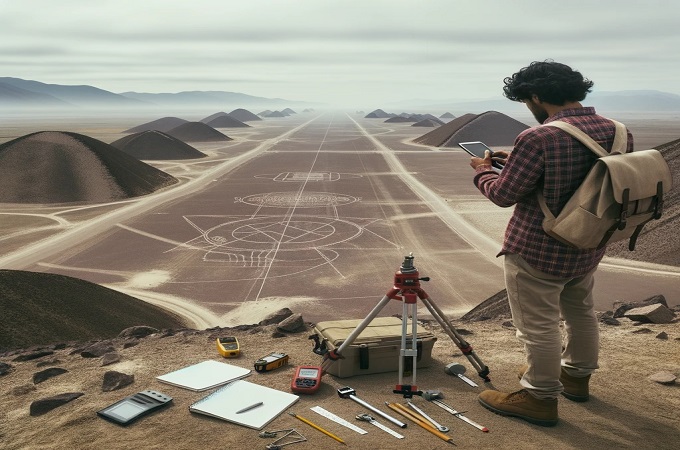
Conservation and Preservation: Safeguarding the Desert’s Timeless Canvas
The Nazca Lines, as ancient as they are magnificent, stand vulnerable to both natural and human-induced threats. The responsibility of preserving these millennia-old geoglyphs falls upon both local communities and global entities. The efforts made in conservation and preservation ensure that the legacy of the Nazca civilization endures for future generations to appreciate and study.
UNESCO World Heritage Status
In 1994, the Nazca Lines were designated a UNESCO World Heritage Site. This recognition has bolstered global efforts to protect and preserve the geoglyphs, emphasizing their cultural, historical, and artistic significance.
Monitoring and Maintenance
Ongoing monitoring is crucial to detect any potential damage or degradation. Regular maintenance, such as the removal of accumulated sand or the reinforcement of eroding lines, is carried out to ensure the geoglyphs remain intact.
Restricting Access
To prevent inadvertent damage, direct access to the Nazca Lines is restricted. Viewing platforms and designated aerial tours offer visitors a way to appreciate the geoglyphs without compromising their integrity.
Combating Natural Threats
The Nazca Desert’s arid environment has, ironically, played a role in preserving the lines for centuries. However, rare rainfall events or shifting sands can pose threats. Efforts are made to redirect water flow and stabilize sand dunes to mitigate these natural challenges.
Addressing Human-Induced Threats
From vehicular trespassing to vandalism, human activities have occasionally threatened the Nazca Lines. Awareness campaigns, stringent regulations, and patrolling have been instrumental in minimizing such incidents.
Technological Interventions
Modern technology, including satellite imagery, drones, and geospatial software, aids in monitoring the Nazca Lines. These tools offer high-resolution insights, allowing for timely interventions and informed conservation strategies.
Community Engagement
Local communities play a pivotal role in conservation efforts. By instilling a sense of pride and ownership, locals become active stakeholders in preserving their ancestral legacy. Educational programs, community workshops, and cultural events reinforce this bond.
Global Collaboration
International experts, archaeologists, and conservationists often collaborate with local entities, pooling resources, knowledge, and expertise. This global-local partnership ensures a holistic approach to preserving the Nazca Lines.
Sustainable Tourism
Promoting responsible tourism is crucial. Tour operators are encouraged to adopt sustainable practices, ensuring that the influx of visitors enriches the local economy without compromising the geoglyphs’ sanctity.
The conservation and preservation of the Nazca Lines underscore humanity’s collective responsibility towards its shared heritage. As we gaze upon these ancient marvels, we’re reminded not just of the ingenuity of the Nazca civilization but also of our duty to safeguard the timeless treasures of our shared past.
Visiting the Nazca Lines: A Journey Through Time and Desert Sands
When one enters the Nazca Desert, a sense of awe and reverence immediately envelops them. The Nazca Lines, with their silent tales and grandeur, beckon travelers from across the globe. If you’re planning to embark on this unforgettable journey, here are some insights and tips to enhance your experience.
Best Ways to View
Given their size and layout, the Nazca Lines are best appreciated from an aerial perspective. Small aircraft tours offer breathtaking views of the geoglyphs, ensuring you capture their full essence.
Responsible Tourism
The fragile nature of the Nazca Lines necessitates responsible tourism. Stick to designated paths, adhere to guidelines, and always prioritize the site’s preservation over personal exploration.
The Maria Reiche Neuman Airport
Named after the pioneering researcher of the Nazca Lines, this airport serves as the primary hub for aerial tours. Before your flight, explore the small museum dedicated to Maria Reiche’s life and work.
Optimal Times to Visit
The Nazca Desert is sun-drenched throughout the year. However, the months between May and November, with their clearer skies, are particularly recommended for aerial tours.
Ground Exploration
While aerial views are unparalleled, there are observation towers and platforms along the Pan-American Highway that offer ground-level perspectives of certain geoglyphs.
Local Guides
Engaging a local guide can greatly enrich your experience. Their insights, stories, and deep-rooted connection to the land add layers of depth to your exploration.
Nearby Attractions
Beyond the Nazca Lines, the region boasts other attractions. The ancient aqueducts of Cantalloc, the Nazca and Palpa valleys, and the Chauchilla Cemetery offer glimpses into the region’s rich history and culture.
Staying Overnight
The town of Nazca, with its range of accommodations, eateries, and cultural offerings, serves as a base for your journey. Staying overnight allows you to explore the region at a leisurely pace.
Cultural Immersion
Engage with local communities, participate in traditional events, and savor regional delicacies. This cultural immersion deepens your connection to the land and its timeless tales.
Commemorate Your Visit
While souvenirs serve as mementos, consider supporting local artisans and businesses. Their handcrafted offerings not only capture the essence of the Nazca Lines but also sustain local economies.
Visiting the Nazca Lines is more than just a tourist endeavor; it’s a pilgrimage into the heart of ancient wisdom, artistry, and cosmic wonder. As you tread softly upon this sacred land, let the desert winds whisper their age-old secrets, and let the geoglyphs transport you to realms beyond time and imagination.
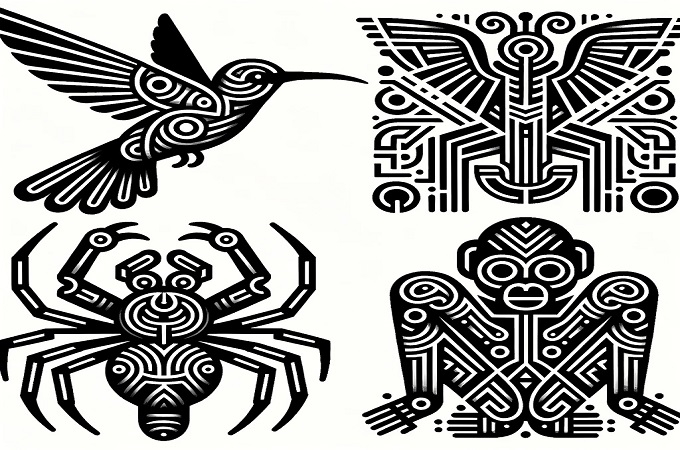
Nazca Lines in Popular Culture: From Desert Sands to Global Imaginations
The enigmatic allure of the Nazca Lines, with their vast scale and ancient origins, has not just captivated historians and archaeologists but also artists, writers, and filmmakers across the globe. Their presence in popular culture underscores their universal appeal and their ability to inspire creativity and wonder.
Literature’s Desert Muse
Numerous authors have woven the mystery of the Nazca Lines into their narratives. Whether as central plot elements, symbolic motifs, or evocative backdrops, these geoglyphs have found their way into poetic verses.
Silver Screen Depictions
Filmmakers, drawn by the visuals of the Nazca Desert, have featured the lines in documentaries, historical dramas, and science fiction. Their aerial shots, capturing the geoglyphs in all their majesty, offer audiences a cinematic journey into ancient realms.
Music’s Rhythmic Homage
Musicians and composers, inspired by the Nazca Lines’ mystique, have crafted melodies, lyrics, and album covers reflecting their enchantment with the desert’s timeless canvas.
Art and Installations
Contemporary artists, utilizing diverse mediums from canvas paintings to digital art, have reimagined the Nazca Lines, infusing them with modern interpretations or juxtaposing them against futuristic landscapes.
Television’s Glimpse into Mystery
Various TV series, especially those delving into ancient mysteries, extraterrestrial theories, or archaeological adventures, have featured episodes centered around the Nazca Lines, introducing them to global audiences.
Video Games’ Virtual Exploration
The world of gaming, with its emphasis on exploration and discovery, has integrated the Nazca Lines into various titles. Gamers can virtually traverse the Nazca Desert, uncovering secrets and delving into narratives inspired by the geoglyphs.
Fashion and Design
The iconic designs of the Nazca Lines, from the hummingbird to the spider, have influenced fashion designers, jewelry crafters, and tattoo artists. Their creations, echoing the lines’ motifs, blend ancient symbolism with modern aesthetics.
Educational Platforms
Beyond entertainment, the Nazca Lines have been featured in educational apps, virtual reality tours, and interactive websites. These platforms offer learners immersive experiences, bridging the gap between history and technology.
The Nazca Lines’ presence in popular culture is a testament to their enduring fascination and universal resonance. As they continue to inspire creativity across genres and mediums, they remind us of the timeless bond between art, history, and human imagination, transcending boundaries and echoing across millennia.
A Desert’s Whispered Secrets and Humanity’s Endless Quest
The Nazca Lines, etched into the heart of Peru’s vast desert, stand as silent sentinels to a civilization long gone, yet their message resonates as clearly today as it might have centuries ago. These geoglyphs, with their intricate designs and sprawling scale, are more than mere markings on the earth; they are profound expressions of a people’s dreams, beliefs, and cosmic curiosities.
In our exploration, we’ve traversed not just the physical expanse of the Nazca Desert but also the vast landscapes of history, culture, and imagination. From theories of astronomical significance to their indelible imprint on popular culture, the Nazca Lines have woven a tapestry of tales that beckon scholars, dreamers, and travelers alike.
Yet, perhaps the true magic of the Nazca Lines lies not in the answers they offer but in the questions they pose. They challenge us to look beyond the visible, to seek connections between the earth and the cosmos, and to embrace the mysteries that lie at the intersection of past, present, and future.
As we step away from the desert’s embrace, let us carry forward the spirit of inquiry, wonder, and reverence. In the whispers of the Nazca Lines, we find a timeless reminder of humanity’s enduring quest to understand, create, and connect.
Read more: Lost Civilizations
Embark on Your Own Desert Odyssey
The tales of the Nazca Lines have been whispered through the winds of time, and now, they beckon you. Will you heed their call?
- Experience the Awe: Book an aerial tour and witness the grandeur of the Nazca Lines from the skies. Feel the rush of history and mystery beneath your wings.
- Dive Deeper: Enrich your understanding with guided tours, immersing yourself in the historical, and astronomical wonders of the Nazca Desert.
- Preserve the Legacy: Join conservation initiatives or support local communities in their efforts to protect these ancient treasures for generations to come.
- Share the Magic: Captured a mesmerizing photo? Unearthed a fascinating fact? Share your Nazca experiences on social media using the hashtag #NazcaOdyssey and inspire others to embark on their own journeys.
The desert awaits, its secrets poised on the horizon. Answer the call, embrace the adventure, and become a part of the timeless tale of the Nazca Lines.
Book Your Nazca Journey Now


